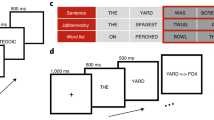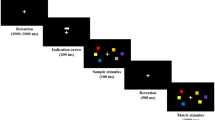Abstract
Recent neuroimaging studies in blind persons show that the occipital cortex, including the primary visual cortex (V1), is active during language-related and verbal-memory tasks. No studies, however, have identified a causal link between early visual cortex activity and successful performance on such tasks. We show here that repetitive transcranial magnetic stimulation (rTMS) of the occipital pole reduces accuracy on a verb-generation task in blind subjects, but not in sighted controls. An analysis of error types revealed that the most common error produced by rTMS was semantic; phonological errors and interference with motor execution or articulation were rare. Thus, in blind persons, a transient 'virtual lesion' of the left occipital cortex interferes with high-level verbal processing.
*Note: The version of this article that was published online on October 3, 2004, listed incorrect affiliations for one author. Amir Amedi is not affiliated with the Human Cortical Physiology Section, National Institute of Neurological Disorders and Stroke, National Institutes of Health, Bethesda, MD 20892-1428, USA. In addition, the original online version failed to note that the Laboratory for Magnetic Brain Stimulation, Department of Neurology, Beth Israel Deaconess Medical Center, Harvard Medical School, Boston, MA 02215, USA is Amir Amedi's present address. The online version was corrected on 10 October 2004, and the printed version of this article is correct.
This is a preview of subscription content, access via your institution
Access options
Subscribe to this journal
Receive 12 print issues and online access
$209.00 per year
only $17.42 per issue
Buy this article
- Purchase on Springer Link
- Instant access to full article PDF
Prices may be subject to local taxes which are calculated during checkout



Similar content being viewed by others
Change history
10 October 2004
updated affiliations
References
Sadato, N. et al. Activation of the primary visual cortex by Braille reading in blind subjects. Nature 380, 526–528 (1996).
Buchel, C., Price, C., Frackowiak, R.S. & Friston, K. Different activation patterns in the visual cortex of late and congenitally blind subjects. Brain 121, 409–419 (1998).
Burton, H. Visual cortex activity in early and late blind people. J. Neurosci. 23, 4005–4011 (2003).
Cohen, L.G. et al. Functional relevance of cross-modal plasticity in blind humans. Nature 389, 180–183 (1997).
Pascual-Leone, A., Wassermann, E.M., Sadato, N. & Hallett, M. The role of reading activity on the modulation of motor cortical outputs to the reading hand in Braille readers. Ann. Neurol. 38, 910–915 (1995).
Burton, H., Snyder, A.Z., Diamond, J.B. & Raichle, M.E. Adaptive changes in early and late blind: a fMRI study of verb-generation to heard nouns. J. Neurophysiol. 88, 3359–3371 (2002).
Amedi, A., Raz, N., Pianka, P., Malach, R. & Zohary, E. Early 'visual' cortex activation correlates with superior verbal-memory performance in the blind. Nat. Neurosci. 6, 758–766 (2003).
Roder, B., Stock, O., Bien, S., Neville, H.J. & Rosler, F. Speech processing activates visual cortex in congenitally blind adults. Eur. J. Neurosci. 16, 930–936 (2002).
Noppeney, U., Friston, K.J. & Price, C.J. Effects of visual deprivation on the organization of the semantic system. Brain 126, 1620–1627 (2003).
Burton, H., Diamond, J.B. & McDermott, K.B. Dissociating cortical regions activated by semantic and phonological tasks: a fMRI study in blind and sighted people. J. Neurophysiol. 90, 1965–1982 (2003).
Pascual-Leone, A., Walsh, V. & Rothwell, J. Transcranial magnetic stimulation in cognitive neuroscience—virtual lesion, chronometry, and functional connectivity. Curr. Opin. Neurobiol. 10, 232–237 (2000).
Levelt, W.J. Spoken word production: a theory of lexical access. Proc. Natl Acad. Sci. USA 98, 13464–13471 (2001).
Hallett, M. Transcranial magnetic stimulation and the human brain. Nature 406, 147–150 (2000).
Malach, R. et al. Object-related activity revealed by functional magnetic resonance imaging in human occipital cortex. Proc. Natl Acad. Sci. USA 92, 8135–8139 (1995).
Amedi, A., Malach, R., Hendler, T., Peled, S. & Zohary, E. Visuo-haptic object-related activation in the ventral visual pathway. Nat. Neurosci. 4, 324–330 (2001).
Lisanby, S.H., Gutman, D., Luber, B., Schroeder, C. & Sackeim, H.A. Sham TMS: intracerebral measurement of the induced electrical field and the induction of motor-evoked potentials. Biol. Psychiatry 49, 460–463 (2001).
Devlin, J.T., Matthews, P.M. & Rushworth, M.F. Semantic processing in the left inferior prefrontal cortex: a combined functional magnetic resonance imaging and transcranial magnetic stimulation study. J. Cogn. Neurosci. 15, 71–84 (2003).
Gabrieli, J.D.E., Poldrack, R.A. & Desmond, J.E. The role of left prefrontal cortex in language and memory. Proc. Natl Acad. Sci. USA 95, 906–913 (1998).
Shapiro, K.A., Pascual-Leone, A., Mottaghy, F.M., Gangitano, M. & Caramazza, A. Grammatical distinctions in the left frontal cortex. J. Cogn. Neurosci. 13, 713–720 (2001).
Floel, A. et al. Prefrontal cortex asymmetry for memory encoding of words and abstract shapes. Cereb. Cortex 14, 404–409 (2004).
Stewart, L., Walsh, V., Frith, U. & Rothwell, J.C. TMS produces two dissociable types of speech disruption. Neuroimage 13, 472–478 (2001).
Poldrack, R.A. et al. Functional specialization for semantic and phonological processing in the left inferior prefrontal cortex. Neuroimage 10, 15–35 (1999).
Korpilahti, P., Krause, C.M., Holopainen, I. & Lang, A.H. Early and late mismatch negativity elicited by words and speech-like stimuli in children. Brain Lang. 76, 332–339 (2001).
Chouinard, P.A., Van Der Werf, Y.D., Leonard, G. & Paus, T. Modulating neural networks with transcranial magnetic stimulation applied over the dorsal premotor and primary motor cortices. J. Neurophysiol. 90, 1071–1083 (2003).
Paus, T. Imaging the brain before, during, and after transcranial magnetic stimulation. Neuropsychologia 37, 219–224 (1999).
Distler, C., Boussaoud, D., Desimone, R. & Ungerleider, L.G. Cortical connections of inferior temporal area TEO in macaque monkeys. J. Comp. Neurol. 334, 125–150 (1993).
Rempel-Clower, N.L. & Barbas, H. The laminar pattern of connections between prefrontal and anterior temporal cortices in the Rhesus monkey is related to cortical structure and function. Cereb. Cortex 10, 851–865 (2000).
Dehay, C., Bullier, J. & Kennedy, H. Transient projections from the fronto-parietal and temporal cortex to areas 17, 18 and 19 in the kitten. Exp. Brain Res. 57, 208–212 (1984).
Buckner, R.L., Kelley, W.M. & Petersen, S.E. Frontal cortex contributes to human memory formation. Nat. Neurosci. 2, 311–314 (1999).
Buchel, C. Cortical hierarchy turned on its head. Nat. Neurosci. 6, 657–658 (2003).
Pascual-Leone, A. & Hamilton, R. The metamodal organization of the brain. Progr. Brain Res. 134, 427–445 (2001).
Boroojerdi, B. et al. Enhanced excitability of the human visual cortex induced by short-term light deprivation. Cereb. Cortex 10, 529–534 (2000).
Oldfield, R.C. The assessment and analysis of handedness: the Edinburgh inventory. Neuropsychologia 9, 97–113 (1971).
Kucera, W.N. & Francis, H. Computational Analysis of Present-Day American English (Brown University Press, Providence, 1967).
Rossini, P.M. et al. Non-invasive electrical and magnetic stimulation of the brain, spinal cord and roots: basic principles and procedures for routine clinical application. Report of an I.F.C.N. committee. Electroencephalogr. Clin. Neurophysiol. 91, 79–92 (1994).
Acknowledgements
We thank C. Wu for help with MRI acquisition; C. Poletto for help and advice on the recording and auditory equipment; D. Glasser, A. Dorsch and M. Skupinsky for research assistance; and our dedicated blind and sighted subjects. A.F. is supported by a grant (Fl 379/1-1) from the Deutsche Forschungsgemeinschaft, Bonn. E.Z. was supported by McDonnell—Pew Foundation grant JSMF#220020046 and A.A. by a Horowitz fellowship.
Author information
Authors and Affiliations
Corresponding authors
Ethics declarations
Competing interests
The authors declare no competing financial interests.
Supplementary information
Supplementary Fig. 1
Scatter plot of the change in error rate (delta ER) versus the change in reaction time (from rTMS onset, delta RT) for each subject and cortical stimulation site in blind and sighted subjects. The absence of points scattered in the second and fourth quadrants of the graph indicate that a speed–accuracy trade-off, which would depend on the occurrence of more errors (delta ER>0) with shorter reaction times (delta RT<0) and vice versa, cannot account for the increase in error rates for either the blind or the sighted subjects. (PDF 186 kb)
Supplementary Table 1
Verb-generation performance: normalized accuracy score ([condition–sham]/sham) for percentage of correct responses. (PDF 19 kb)
Supplementary Table 2
Verb-generation performance. (PDF 19 kb)
Rights and permissions
About this article
Cite this article
Amedi, A., Floel, A., Knecht, S. et al. Transcranial magnetic stimulation of the occipital pole interferes with verbal processing in blind subjects. Nat Neurosci 7, 1266–1270 (2004). https://doi.org/10.1038/nn1328
Received:
Accepted:
Published:
Issue Date:
DOI: https://doi.org/10.1038/nn1328
This article is cited by
-
Superior verbal but not nonverbal memory in congenital blindness
Experimental Brain Research (2022)
-
Visual cortex recruitment during language processing in blind individuals is explained by Hebbian learning
Scientific Reports (2019)
-
The development of white matter structural changes during the process of deterioration of the visual field
Scientific Reports (2019)
-
Studying and modifying brain function with non-invasive brain stimulation
Nature Neuroscience (2018)
-
Multidimensional encoding of brain connectomes
Scientific Reports (2017)



